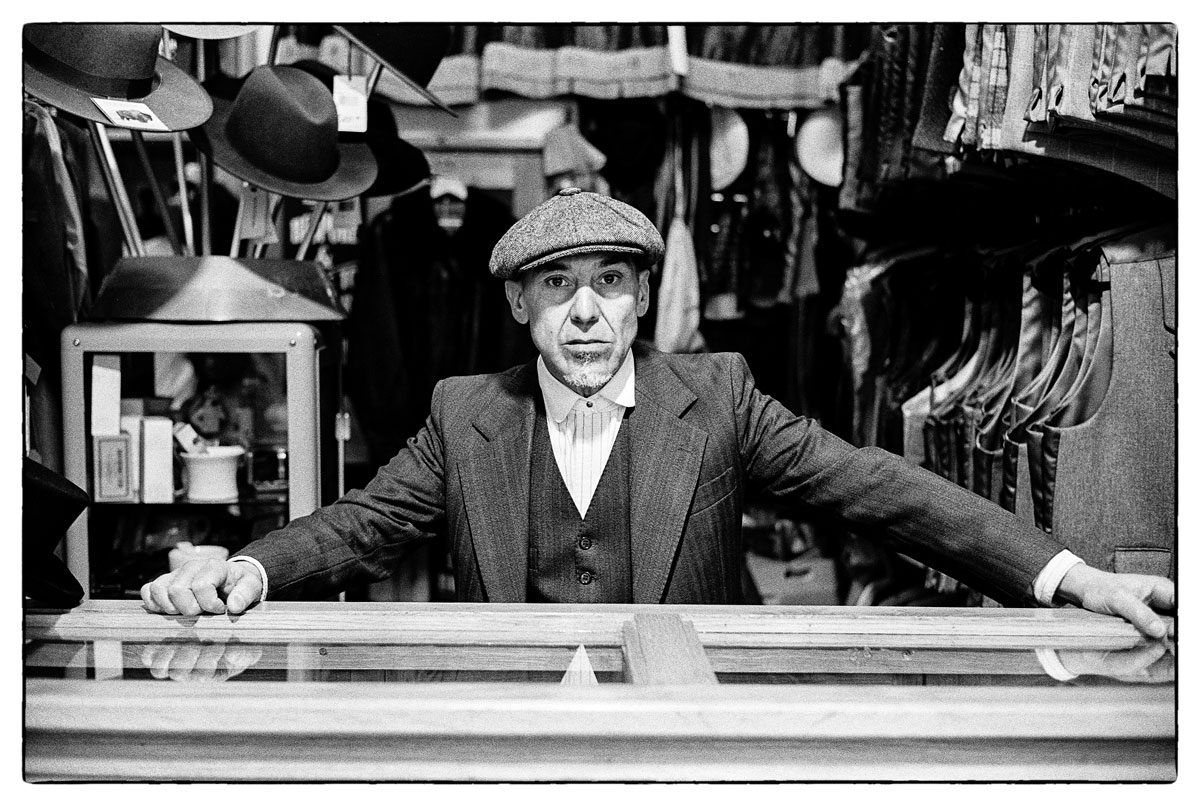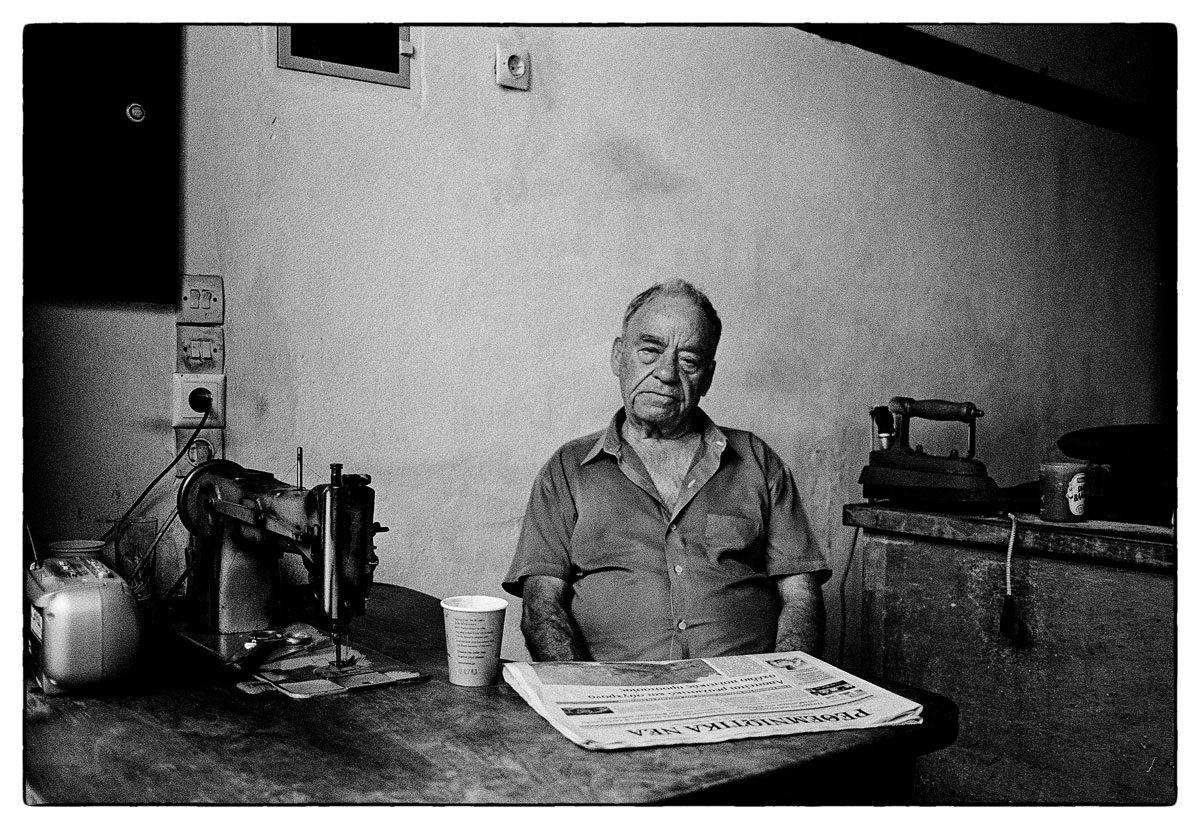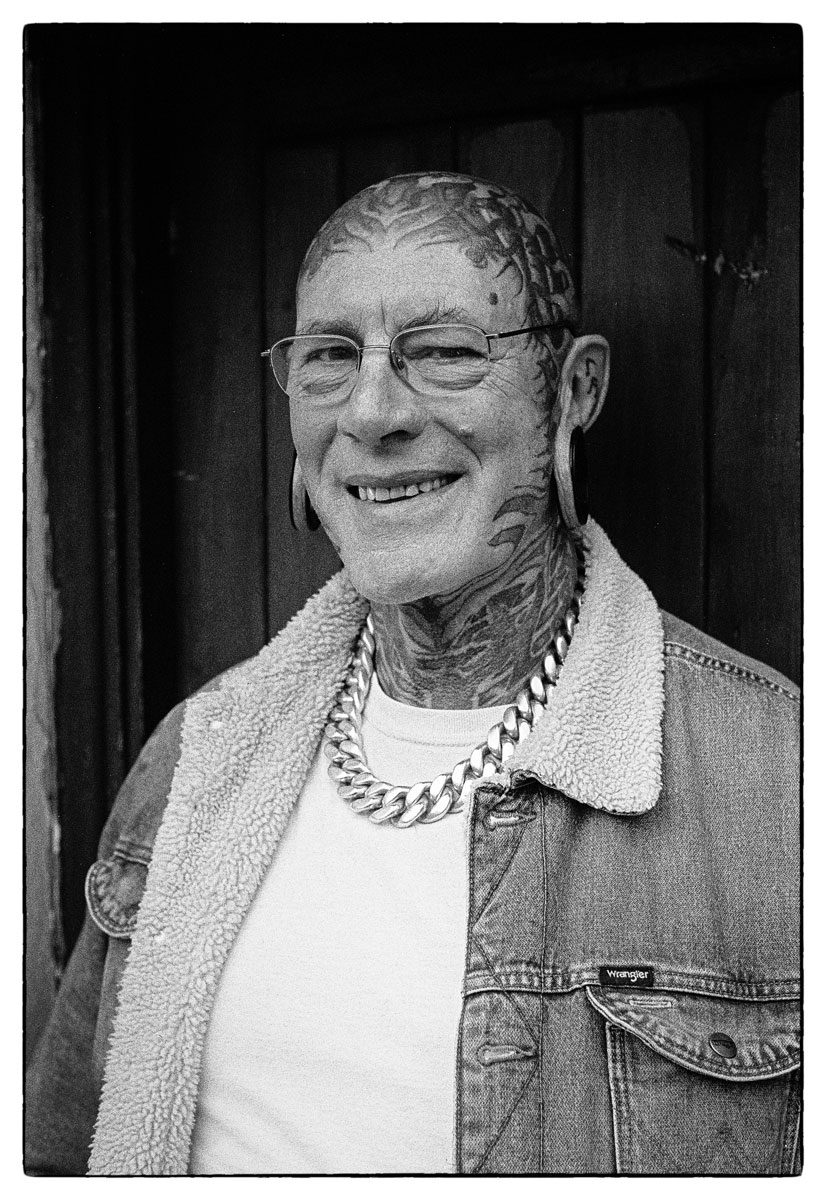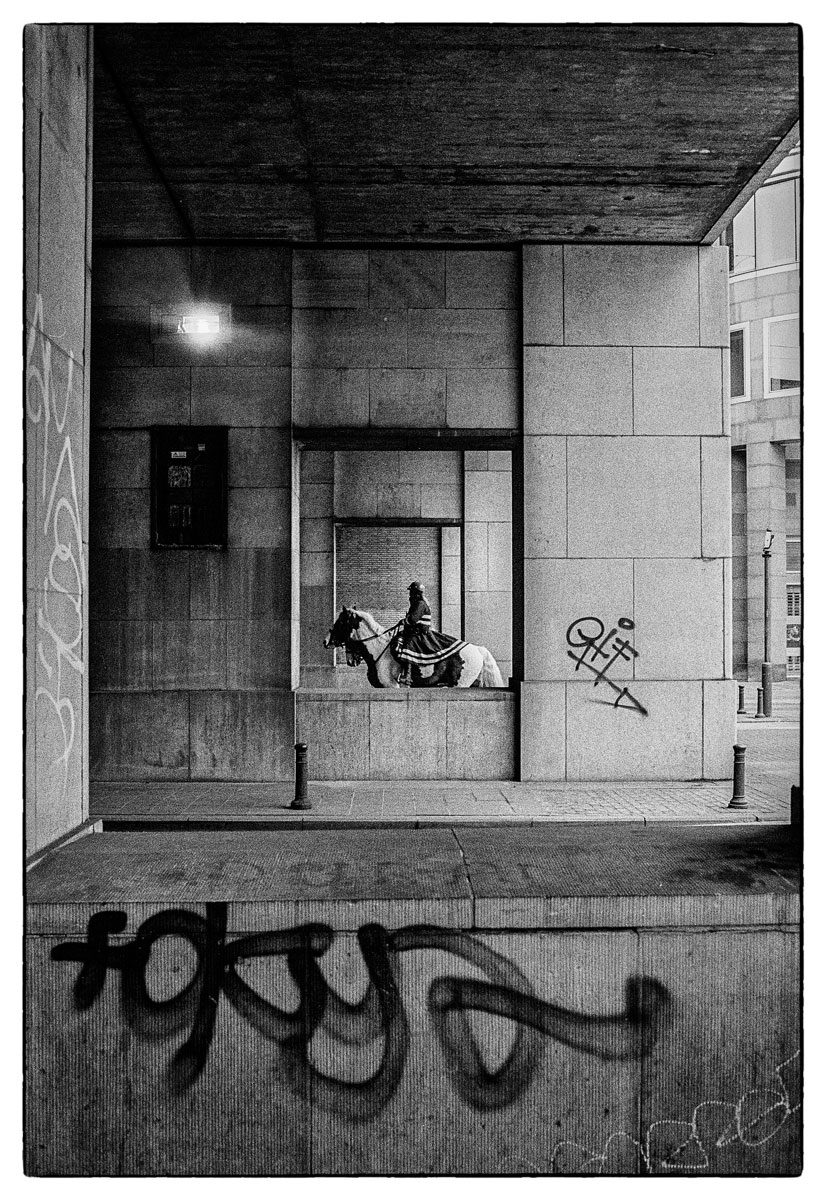In Focus - David Collyer Posted On 18th January 2021 To Magazine & In Focus

Nominated originally by Keith Moss back in November of last year. David Collyer is the 31st interview in this series. A documentary photographer who chooses to shoot around themes or projects. David's is probably best known for one of his recent projects All in a Day's Work which received international recognition.
Section 1 - Background
SHARE YOUR FAVOURITE IMAGE / PRINT SHOT ON ILFORD FILM AND TELL US WHAT IT MEANS TO YOU?
Blimey! That’s like being asked to choose your favourite child and then explaining why! The one that springs to mind is of a guy I shot in Hereford, who is known to all as Simon Spoons, because he busks playing the spoons along to a very eclectic mixture of different types of music. He has the type of face and demeanour that a photographer such as myself who deals largely in dramatic street portraiture cries out for. A face that looks like it was hewn from the rock by an age of weather damage, clothes that have seen better days, and a character that could fight it’s way out of a locked concrete bunker.
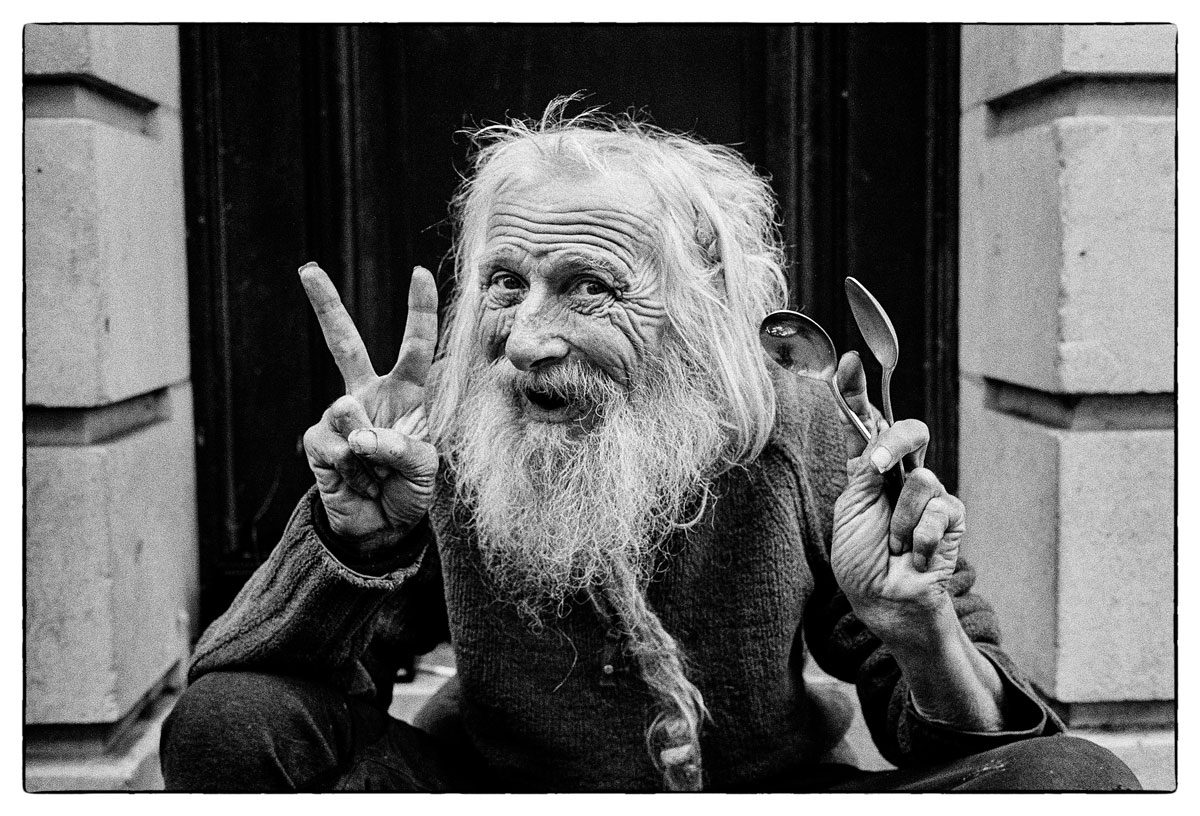
Simon-Spoons Legendary busker. Leica M3, HP5+ at iso 800
The reason this portrait is important to me is that it shows that you never know when a good photo opportunity will arise. I’d visited Hereford for the day, and had fallen totally flat after a fallow couple of weeks; deserted by both inspiration and opportunity. I was on my way back to the train station feeling despondent when I rounded a corner to see Simon. I got chatting as I try to always do, and then took out my Leica M3 loaded with HP5+ at 800 ISO and fired off a few shots. To me, not only is this a good photo which really conveys who the person is, but it shows the importance of always being ready, and not giving up
Just in case anyone doesn’t know who you are or what you do can you give us the overview?
I’m a photographer based in South Wales who really concentrates on a documentary style of work. I tend to shoot around themes, and work on a few long term projects at any one time. I’m particularly interested in who we are as a nation, and specifically how my generation of fifty something men are so different from our fathers’ generation, still carrying as we do the reminders of tribal fashion from our youth. I also spend a lot of time shooting the post industrial revolution landscape of South Wales. I’m interested in the scars left behind by previous generations, long gone.
I guess I’m most well known for my project All in a Day’s Work which documented the effect of working during the Covid crisis on the staff of a District General Hospital, Nevill Hall in South Wales. This received international recognition and publication, including the front page of the Guardian and a double paged spread inside, as well as a feature in analogue photography magazine Silvergrain Classics, and Amateur Photographer, where I understand one of my photos has been chosen by a columnist as his photo of the year. The project was shot entirely on film, partly HP5+, and with a humble Olympus XA3. It’s been a pretty crazy year!
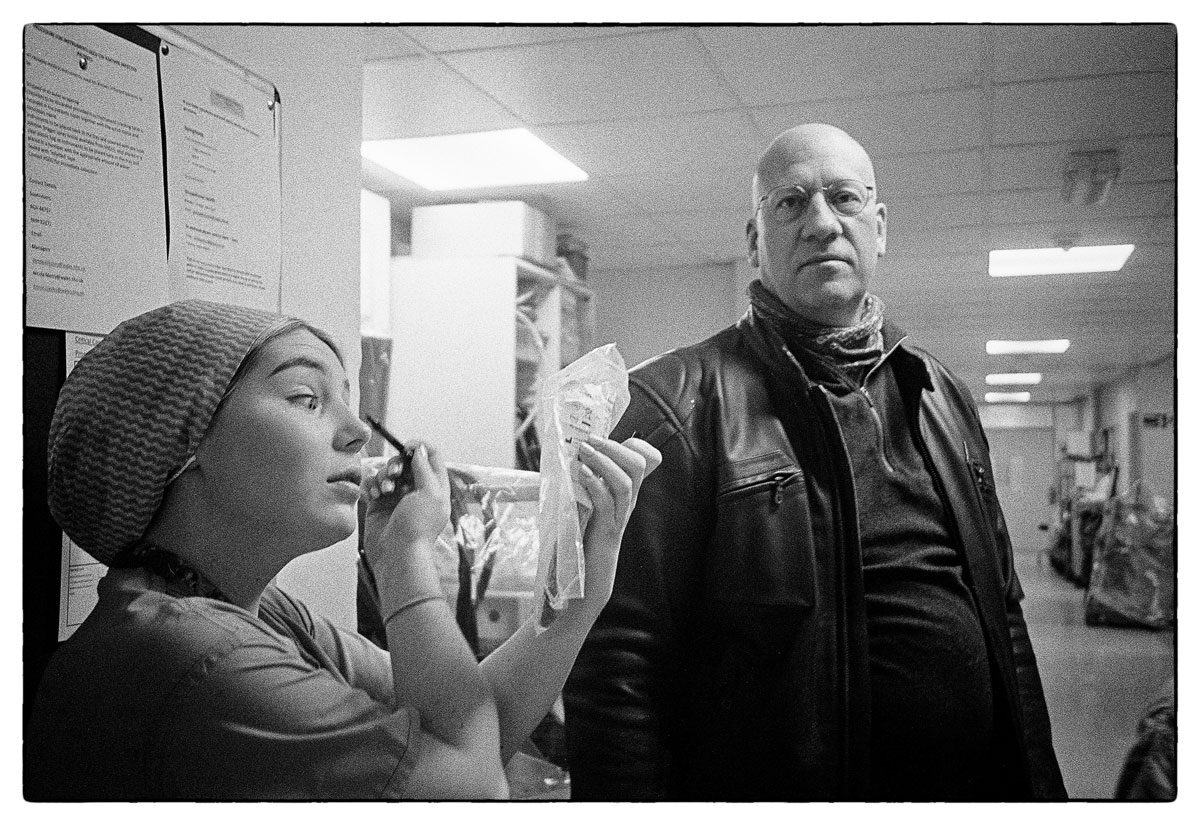
ODPs-Sadie-and-Pete Mascarra for the morale, Olympus XA3, HP5+ at iso 800
How and why did you get started shooting film?
I bought my first camera, a Zenit E, in around 1982. With money I saved up from a gardening round in the village in Surrey where I grew up.I was inspired by a kid who sat next to me at school who had a Praktika. Luckily, my father was a local newspaper editor, so I grew up in newsrooms, and got to hang out with the press photographers, going out to jobs and spending time in the darkroom. It was a really good way to learn not only the technical aspects of photography, but also what it takes to make a good photo with regards to interacting with a subject.
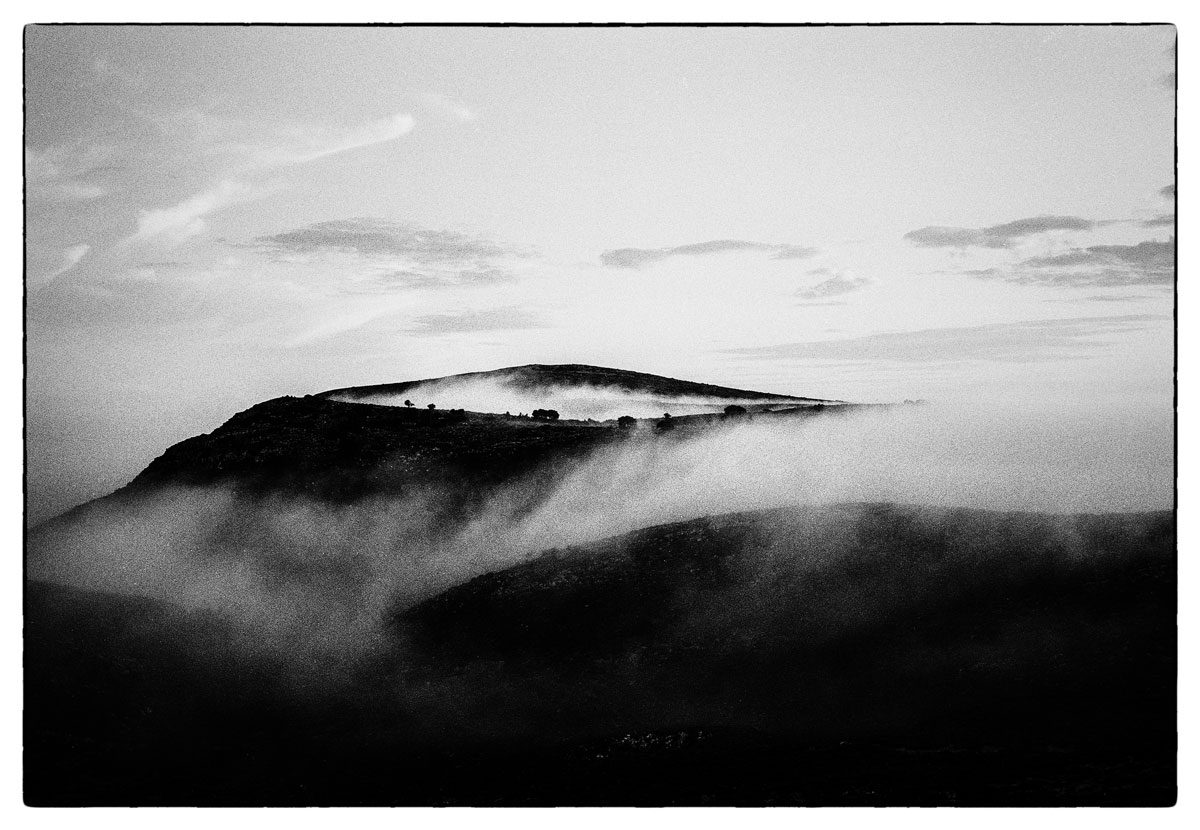
Misty-Mountain-Hop - Dusk on a Cretan mountain, Canon F1, HP5+ at iso 800
Who has been your biggest photographic inspiration to date?
The two photographers who are probably most responsible for the way I shoot, and why I shoot what I do, are Don McCullin and Chris Chapman, both masters in the world of documentary photography and photojournalism.
McCullin really needs no explanation, as famous as he is, but it’s his meticulous and dogged pursuit of perfection under the most arduous and terrifying conditions, and the ultimate respect that he shows to his subjects that makes him a hero to me.
Chris Chapman is a Dartmoor based photographer who I discovered in 2000 when he released a book called Wild Goose and Riddon, documenting the demise of a traditional way of life in farming on the Moor. His work is beautiful, and portrays an timeless existence of the community that he has lived amongst and made his own, since leaving college as one of David Hurn’s first students on the famous Newport documentary photography course in the early 1970s. I sold the book when as a very skint mature student some years ago I needed funds. I’ve since bought another copy, and Chris and I have become friends. His work inspires me still, and he’s very generous with advice on photography and life!
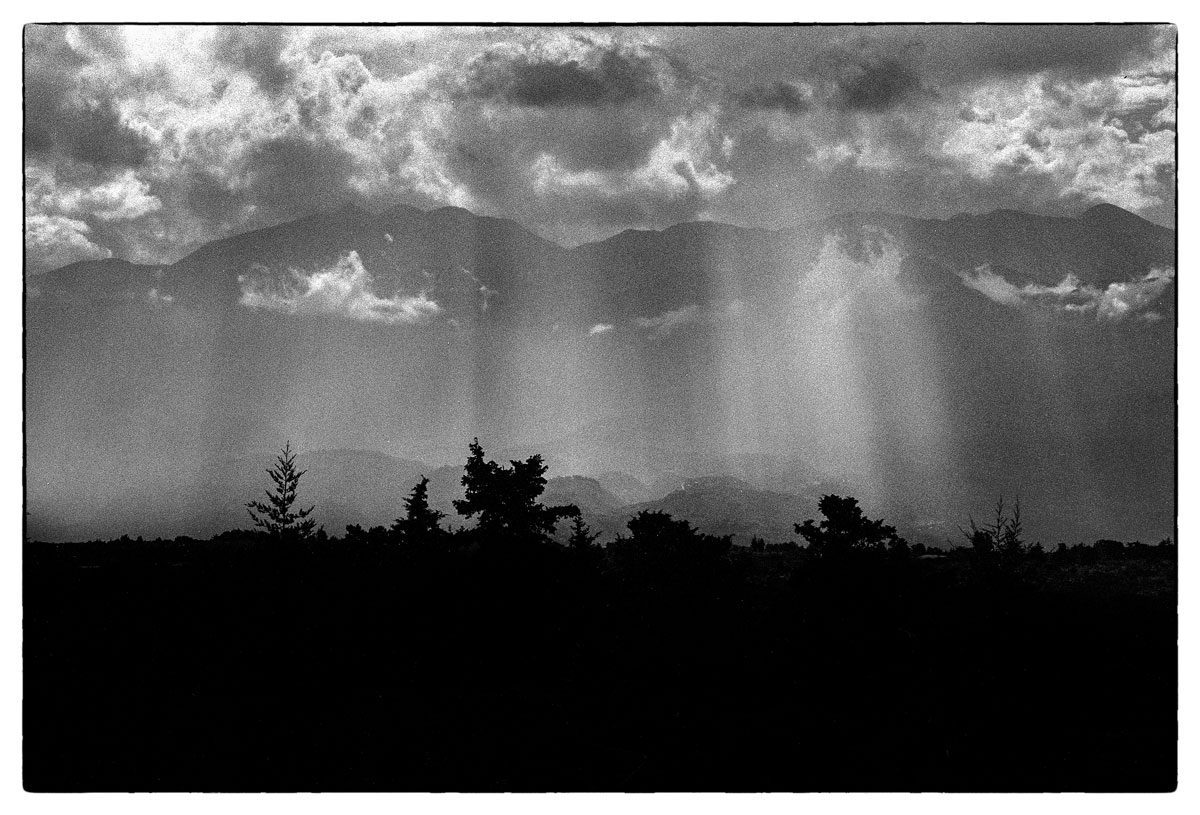
What is the best piece of photography tip or advice you have ever received?
“Take photos of what you like”. It sounds very simple, and it took a good many years to register. The chief photographer on my father’s paper, a guy called Terry Habgood, told me this when we were at Brands Hatch photographing the British Grand Prix in the early 80s. I think we all as photographers start out experimenting with different genres, trying to be edgy, emulating others. It’s not until we embrace what’s within us that really gives us satisfaction and joy, that we find our drive, and for me, find success.

Street portrait of a man in Cardiff
What film photography related projects are you currently working on (or are in the pipeline)?
The book All in a Day’s Work is hopefully coming out soon in a hardback version, and there is also a plan to release a project in print form based on the journey mannequins make from couture to junk yard. I’m shooting 50 Plus, looking at men of my generation, a project which I’m hoping to exhibit in South wales soon, called Iron Mountain, and I’m in the embryonic stages of shooting a project looking at people living as normal a life as possible despite having cancer. Ironically I’ve been diagnosed with bladder cancer myself since starting that one. I’ve also started doing occasional shoots for a new magazine called Detail, dedicated to the Mod lifestyle, and I write a photography column for a local magazine group. All this on top of a career as an Operating Department Practitioner in the NHS. I’m keeping busy!
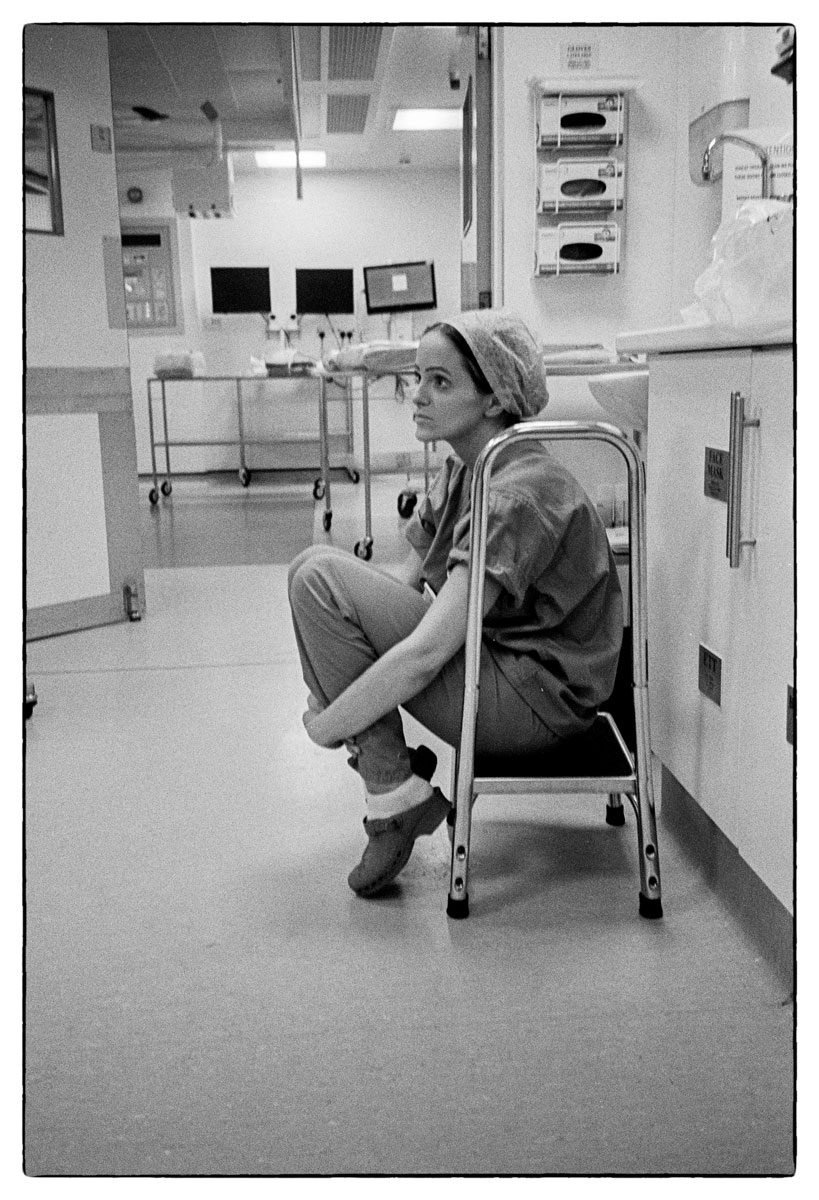
What / where is your next shoot and how do you decide what film / kit you will use?
I’m hoping to get out this weekend and do some more work on the Iron Mountain project. I’ll be using HP5+ pushed a stop as I nearly always do. I’ll probably shoot medium format for what I have in mind, and the camera of choice will be a Mamiya C330. I love the way it slows me right down.
What are your photographic goals going forward? (Can be business or personal).
I’d like to release a book of photos that I’ve taken of the British Public at work and play. Hopefully I can bring a publisher on board with that. I’ve also started to mentor others, so I’d like to pass on my experience and knowledge to others who are on the way up.
- Cardiff-Market Vintage clothes seller in Cardiff, Leica M3. HP5+ at iso 800
- Tailor – A backstreet tailor in Crete, Canon F1, HP5+ at iso 800
Section 2 - Shout outs
We all need a bit of inspiration and love so this is your chance to tell the community about yours – from the film photographers whose work inspires you, the labs you trust with your film, your ‘go to’ film photography stockists, your favourite community darkrooms or just anyone in the community who you feel deserves a special mention.
Give a shout out to your 3 favourite film photographers (not photography hubs) currently active on IG or Twitter and briefly tell us why others should follow them.
Ok. My first choice is a bit cheeky. It’s my son Ned who is currently in the first year of a photojournalism degree at UAL. He’s a film shooter, incredibly talented, and already has an iconic photo under his belt of the Colston statue being pulled down during the BLM protests in Bristol. I’ve never had to push him, but it’s been obvious since he was around three years old that photography runs through his veins. @nedcollyer on Instagram
Secondly, I’m going to choose Jim Mortram. His work on the effects of austerity as portrayed in his book Smalltown Inertia, is seminal, and highlights so much that is wrong in a society governed to facilitate the amassing of wealth by a few at the expense of many. Jim is a full time carer for his mother and has been for over twenty years. Not only is he a superb photographer whose work shines out, he’s a top human being. @JAMortram on Twitter
Thirdly, Kate Bellis, a photojournalist documenting life in the Peak District. I discovered Kate when I bought a framed print in a charity shop in Devon, and did a bit of research which very quickly led me to the discovery that the £19.99 that I spent was a very, very good investment indeed. It’s also turned out to be a great personal investment, as Kate has also become a friend, and in some ways a bit of a mentor, as have so many others since I achieved some recognition myself. Her work has a simple beauty. Nothing flash, but incredibly well crafted images that show a real passion for, and understanding of the people and places she photographs. @katebellisphoto on Instagram, and @KateBellis7 on Twitter
- Alistair – 50Plus Project, Leica M3, HP5+ at iso 800
- Call the cops A mounted police horse in Brussels, Canon F1, HP5+ at iso 800
Give a shout out to your favourite photography YouTube channels (apart from the @ilfordphoto one).
I must admit, when I’m on Youtube it tends to be watching music, another passion. When it comes to photographic inspiration I tend to be more book based.
Give a shout out to your favourite photographic retailers (name, location and website).
Cambrian Photography in Colwyn Bay. Sarah is very enthusiastic, incredibly helpful, and recently sold me a Leica Elmar 50/2.8 at a price that really made me smile!
Give a shout out to your favourite lab service, if you have one, (name, location, website).
I process and scan all my own negatives, but printing is done for me by Photographique in Bristol. A really good team who offer a superb service. I should also mention the local shop Shackleton’s here in Abergavenny who offer an excellent service, and I’ve used many times over the years
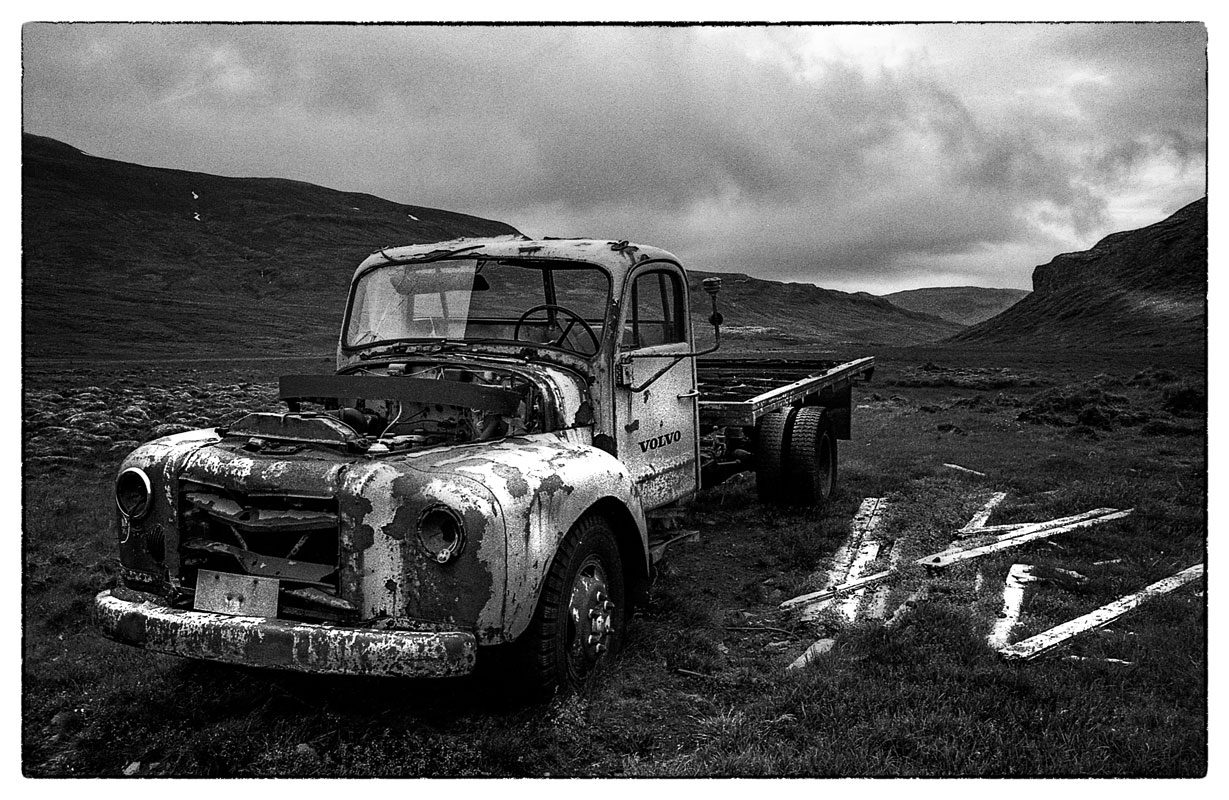
Volvo's a state - 3am on a mountain in Iceland, Olympus OM1, HP5+ at iso 800
Section 3 - Favourite kit
What film cameras do you own and which is your favourite? (Please send us a picture of it if you can).
I’m very lucky. I have a choice of several, but the camera that will have to be prised from my cold, dead hand is a 1959 s/s Leica M3 when coupled with a Summaron 35/3.5. It’s every bit as good as its heritage and reputation suggest. My other go to cameras are the last incarnation of the Canon F1, and a Mamiya C330. If I’m out on my bike I always have my Olympus XA3 with me.
Aside from your camera, lenses and film what accessories make it into your camera bag?
The bag is always one of three Billinghams; one I’ve used almost daily for 25 years. I never go out without a Sekonic L308 lightmeter, a Swiss Army knife, and a lens pen. Also a Moleskine notebook and pen.
What is the best piece of photography kit that you have found or been gifted?
An Olympus XA3 in a local junk shop for a fiver. It put me on the front page of a national newspaper, and made my name as a photographer
As this is an ILFORD interview it would be remiss of us not to ask about your favourite ILFORD products. Tell us you favourite ILFORD film, paper or chems and why?
HP5+ is an incredibly versatile film. I can push it easily to 3200 and it behaves as I want it to, and is as reliable as it gets. I also find that in these days of home scanning it has a grain structure that doesn’t become overly obtrusive. I could never have too much in my fridge. ID-11 is a superb developer, enabling me to push with no problem, and I’ve recently been turned on to Perceptol for when I shoot at box speed or pull the film in brighter times.
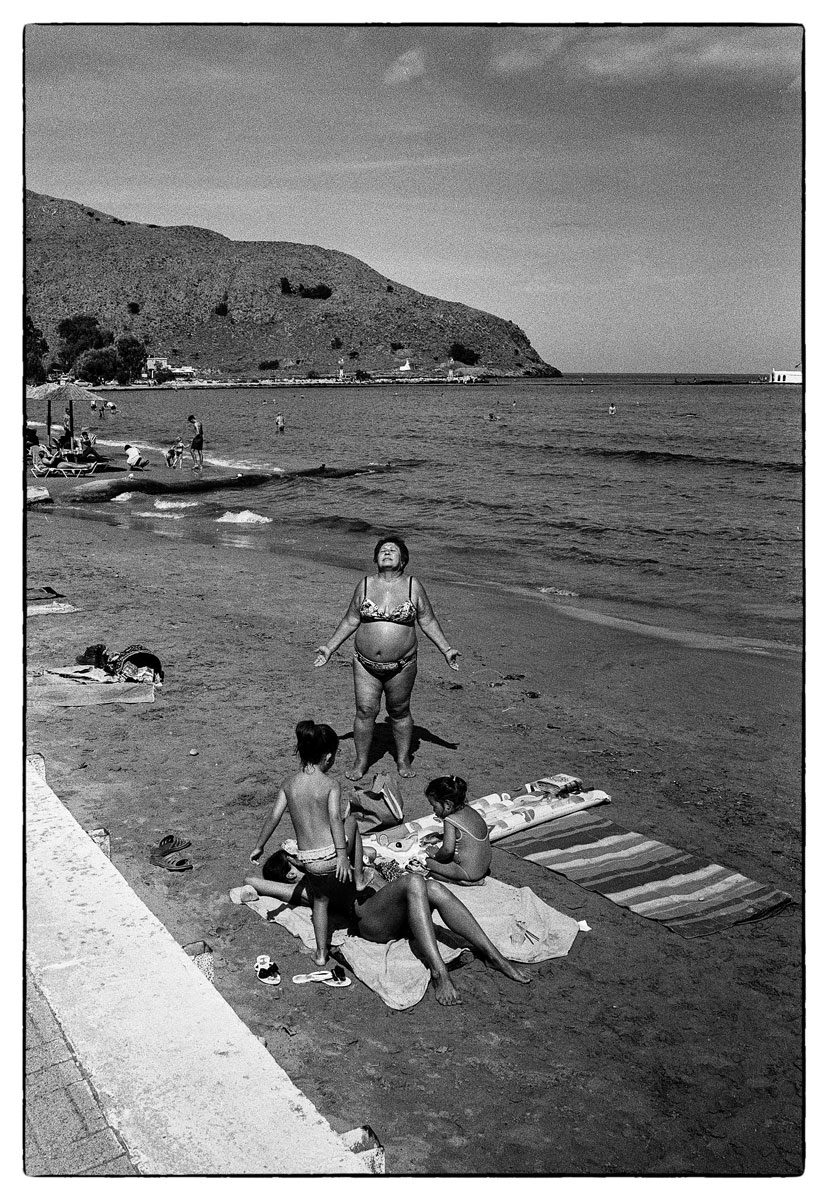
And finally…
Nominate one other person you think should fill in this form and we will reach out to them
It’s a very tough choice between Jim and Kate, but I think it has to be Kate Bellis. She’s a photographer whose work deserves a wider audience.
All images @David Collyer
About The Author

David Collyer
I work full time for the NHS as an Anaesthetic Practitioner, but combine this with my passion of photography. I’m lucky that I earn money from the latter, but the former, I job I love means that I don’t have to compromise in the subject matter that I shoot. I started shooting film in the 1980s under the tutelage of newspaper photographers, but have really started to take photography seriously as a parallel career in the last few years. I returned to shooting film almost exclusively 3 years ago, after deciding that I was spending more time looking at the back of a digital camera than I was at what was in front of it. I’m very proud that this year I put a news photo on the front page of a national newspaper, shot on film, proving that there is still a place for the medium in current affairs photography
Find David on social media
Twitter @nedsoldman
Facebook https://www.facebook.com/nedsoldman/
Instagram @david_collyer_photographer/







